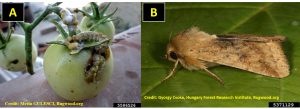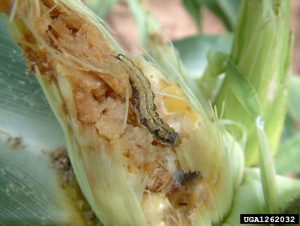The Old World Bollworm (OWB), Helicoverpa armigera (Hübner), was detected in Puerto Rico in 2014 and was reported for the first time in the continental United States (Florida) in 2015. This pest is also called cotton bollworm. The OWB can attack and cause injury to an extensive range of host plants. In Florida, OWB can severely impact crops, such as cotton, corn, and tomatoes.

The corn earworm (Helicoverpa zea) is a close relative of the OWB, and it is difficult to tell them apart based on their morphology alone. Interestingly, the corn earworm causes similar damage and to related crops as the OWB.
Primarily, larvae of the OWB create holes on fruits or flowers, through which they enter the plant. They start feeding inside the fruit or flower, causing damage as they move around. Also, they may choose to feed on the leaves of the preferred host.
Besides the direct injury the OWB causes to plants, they create opportunities for other pathogens to invade the plants to cause additional damage.
The local and international movement of infested commodities (fruits, vegetables, and other plants) facilitate their introductions and spread.

Because of how damaging this pest can be to the Florida fruit and vegetable industry and the challenges of controlling it once introduced, caution is needed when bringing fresh agricultural commodities into the state.
All fruits and vegetables (or plant materials that could potentially harbor OWB) must pass through agricultural inspectors for clearance to be OWB-free. ‘An ounce of prevention is worth a pound of cure.’
There is an ongoing collaborative effort by the U.S. Department of Agriculture and the Florida Department of Agriculture and Consumer to protect U.S agriculture from this pest.
Check out these publications about the OWB and corn earworm for more information.
Picture credits for the featured image are as follows:
- Picture of larva on leaf: Antoine Guyonnet, Lépidoptères Poitou-Charentes, Bugwood.org (#UGA1262033).
- Picture of larva: Todd Gilligan, LepIntercept, USDA APHIS PPQ, Bugwood.org (#51555958).
- Picture of an adult moth: Julieta Brambila, USDA APHIS PPQ, Bugwood.org (#5389264).
 0
0
